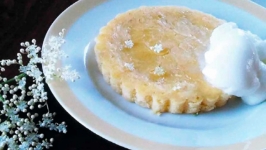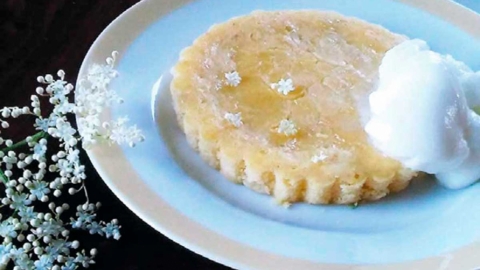Foraging for Food: Walk on the Wild Side
It’s a drizzly day, but June is my busiest month, and so I lace up my Timberlands, toss on my ancient bucket hat, grab a worn muslin bag, and head out. Maybe the rain will thin the shore crowds.
By the time I get home, I’m damp, stained, muddy, scratched, and sleepy. But I also have the immense satisfaction that comes from relying on my own abilities to provide for myself—even just a bit—and the treasure to prove it.
I’m a forager and have been since I was a grade-schooler. We Gen Xers spent a fair amount of time in front of our Atari consoles, no question. But the rest of the time, at least in my tiny shore town, we tore around outside—squealing at the sharp odor of wild onions or carefully breaking off the base of honeysuckle blossoms and drawing out the style to taste a bead of nectar.
Kids tend to have a profound connection to the earth. I suppose I just never outgrew it.
I forage year-round. Most of what I gather I eat straight out of my sticky hands or use in baking. Sometimes chefs and mixologists commission me to forage for them as well. Pastry chef and The Baker’s Grove (Shrewsbury) owner Matthew Rosenzweig is a fellow forager and frequent client, featuring my findings in his beautiful desserts.
“There’s a sense of excitement in discovering things unknown to you and an empowering knowledge in learning about them,” says Rosenzweig. “I wanted to bring this sense of discovery and joy to our customers—most of whom were not familiar with some of these foraged gems—by offering treats that showcase foraged fruit and florals. It’s a great opportunity to connect with our local natural environment.”
During the pandemic I was doubly blessed by foraging—one, because finding produce in grocery stores was often iffy; and two, because despite everything I couldn’t do during lockdown, I could still breathe safely outdoors and gather healthy food, just as I always had. The plants didn’t know the world was in crisis. And for a few hours I could feel normal, and rest in their company.
Here’s a taste of what’s growing underfoot and all around in New Jersey, now through late summer.
- June -
Mulberries. Black mulberries (Morus nigra) look like elongated blackberries; white mulberries (Morus alba) are elongated, too, and are actually pale yellow. They’re both best when tender; in fact, the most efficient way to harvest them is to spread a tarp under the tree, give the trunk a shake, and let the ripe berries fall.
Mulberries belong to the fig family. The leaves vary greatly in shape, even on the same tree, but many will look exactly like fig leaves.
Look for a smudge of purple beneath trees growing along pavement: That’s the black mulberry’s calling card. The trees are often found by lakes or streams because the neighboring water keeps the fruit from dropping prematurely.
Elderflowers (Sambucus). Creamy white and sweetly fragrant—usually. Smell them before you harvest them; location can affect scent. The lacy heads are disc-shaped and are made up of dozens of individual flowers. Delicious infused into a simple syrup (see sidebar) and served in cocktails.
Blackberries (Rubus allegheniensis). The Rose family has a huge extended family, which includes this berry. The fruit grows on thorny canes, just as roses do. Wild blackberries are usually smaller and tarter than their cultivated counterparts. (A general rule of thumb when foraging: Fruit will often be smaller and the flavor more pronounced.)
Honeysuckle (Lonicera japonica). You’ll probably smell these sweet flowers before you see them. They’re a non-native species, so planting them isn’t advised. But if you come across them on a roadside on your way back from the beach, harvest a few handfuls and make syrup (see sidebar). Yellow blossoms are more intensely flavored than white.
Peppermint (Mentha piperita). Sometimes you’ll be hellbent on finding a certain plant and then happen upon something you never expected. One fine day, I was looking for blackberries down at the lake when I spotted something growing profusely, with opposing, slightly serrated leaves like the mint my mom used to grow. I rubbed a leaf between my fingers and inhaled a powerfully aromatic mint smell. Wow.
These plants begin popping up in early spring and last until the first frost. The dried leaves make a lovely tea. Fresh ones will perk your tabbouleh right up, and are nothing short of spectacular in a mojito.
- July -
Wineberries (Rubus phoenicolasius). This sticky, bright vermillion fruit, another member of the prolific Rose family, is assertively tart. (Imagine a raspberry that lives in the East Village and sometimes fills in as a rhythm guitarist at a basement bar.) These berries grow on reddish, fuzzy-thorned canes. I’ve always wanted to make homemade hot sauce with them as a fruity base. This might be the year, as long as I can keep from polishing them all off on the walk home.
Purslane (Portulaca). A lemony-flavored succulent that’s happy in sandy soil, you’ve probably deemed this a weed and yanked it out from among your azaleas. But it’s tasty and loaded with heart-healthy omega-3 fatty acids. Toss the leaves raw into salads or blitz them with garlic and oil into pesto.
- August -
Concord grapes (Vitis labrusca). Pale green when immature and black-violet when ripe, these are a challenge to harvest, so when it works, you strut. The grapes grow clustered amid tangled vines that need to be drawn back like a heavy curtain to access—that’s if you make it beyond the poison ivy and are tall enough to reach them. But their deep, sharp sweetness is unforgettable.
During one bumper year, I brought a bartender a bag full of these grapes, which are named after their city of origin, Concord, MA. I suggested he serve whatever he concocted from them in shot glasses so he could call the drink “The Shot Heard Round the World.”
Beach plums (Prunus maritima). Another Rose cousin, and the bushes look like little apple trees (yet another cousin! This article is a veritable Rose family reunion). These wild plums were a favorite of the Lenni Lenape, New Jersey’s indigenous people.
An octogenarian neighbor, whose mother used to forage on Sandy Hook beach in the early 20<sup>th</sup> century, introduced me to this marble-sized fruit. We drove out there early one morning and harvested gallons and gallons, all of which he brought to a friend to make into his favorite jelly.
When foraging for beach plums, you’re also contending with cacti underfoot, poison ivy, mosquito swarms that sting right through your jeans, ancient branches that scratch up your arms, and the odd swooping bat. It’s worth it.
WORD TO THE WISE: Safety First
Mycologists (mushroom specialists) have a saying: there are bold mushroom foragers and there are old mushroom foragers … but there’s no such thing as a bold, old mushroom forager.
The same applies to all plant foragers. If you aren’t 100% sure of what you’ve found, don’t eat it. I’ve been at this for probably 20 years, but I still keep my trusty, old-school National Audubon Society Field Guide to the Mid-Atlantic States close by (it goes far beyond birds). Chat with your county parks system for more trustworthy resources.
Steer clear of eating anything that’s growing on a suburban lawn, which might be treated with pesticides. And avoid foraging close to a sidewalk (dogs are gonna dog).







